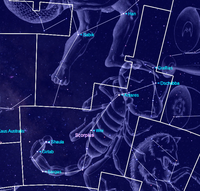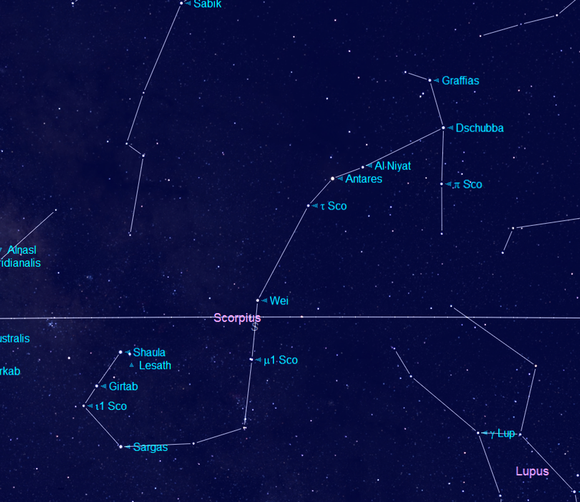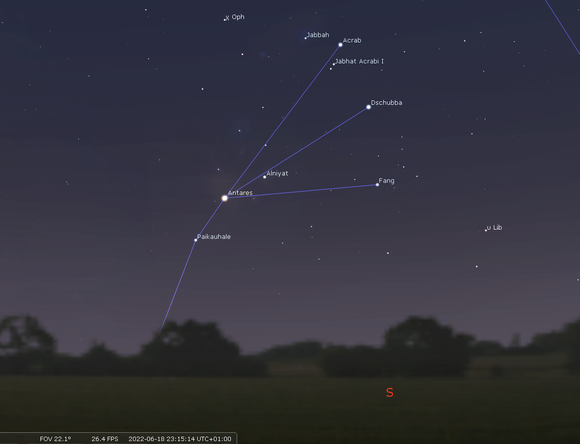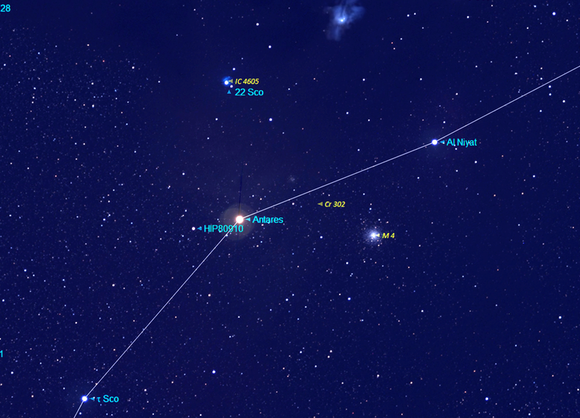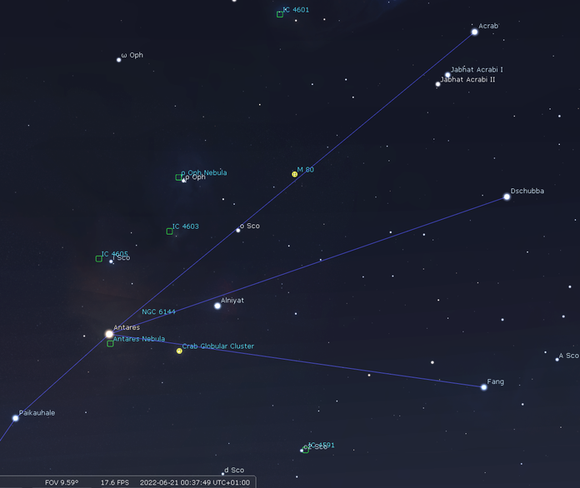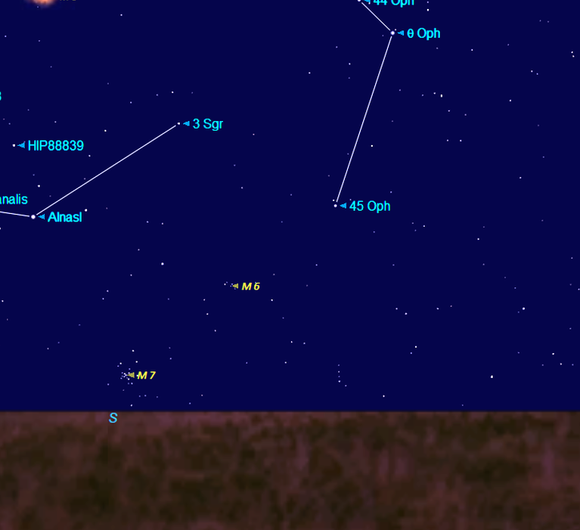Scorpius is a wonderful constellation to explore, whether with the naked eye, binoculars, telescope or imaging. It is such a pity that from the UK and locations of a similar latitude, only the top half of the constellation is visible above the horizon, more southerly locations fully benefitting. It is one constellation that does resemble the object/creature it depicts in the sky - a Scorpion. In Greek mythology, Scorpius and Orion are often intertwined. According to one myth, Orion boasted that he could hunt and kill every animal on the earth. The goddess-hunter Artemis dispatched a scorpion to sting and kill Orion, where after Zeus placed both in the heavens, but at different sides of the sky. In another myth, the god Apollo, Artemis's twin brother, grew angry when Orion claimed to be a better hunter than Artemis and sent a scorpion to attack Orion. Zeus placed both in the sky, but they are visible at different times of the year, Orion is said to be fleeing from the scorpion as it sets just as Scorpius rises.
In ancient Greek times, the constellation Scorpius was significantly larger and comprised of two halves, one with the scorpion’s body and the sting, and one containing the claws. The latter was called Chelae, or “claws.” In the first century BC, the Romans turned the claws into a separate constellation, eventually becoming the Scales of Libra.
In size, Scorpius ranks 33rd, occupying an area of 497 square degrees. It contains 18 named stars of which Antares - 'the rival of Mars', is the 15th brightest in the night sky and is a red supergiant star with a visual magnitude of 0.96, approximately 550 light years distant from the Sun. The star belongs to the spectral class M1.5lab-b and has a solar radius over 800 times greater and is approximately 10,000 times more luminous than the Sun. It has a mass between 15 and 18 solar masses. The star’s estimated age is about 12 million years.
- Shaula - λ Scorpii (Lambda Scorpii) is the second brightest star in Scorpius and at magnitude 1.58 is the 25th brightest star in the sky. It lies approximately 700 light years distant from the solar system. From mainland UK Shaula sits just below the horizon, but can be glimpsed from the far southern extremities of the UK.
- Of the stars that are clearly visible from the UK, Paikauhale – τ Scorpii (Tau Scorpii) which sits lower left of Antares, is a hydrogen fusing dwarf star with a strong, complex magnetic field. The star has the stellar classification B0.2V and is some 18,000 times more luminous than the Sun and 15 times more massive. It has an apparent magnitude of 2.82 and is approximately 470 light years distant. Tau Scorpii is a popular target for spectroscopy astronomers because it shows a very clear spectrum having a slow rotation.
- Fang – π Scorpii (Pi Scorpii) is a triple star system with a combined visual magnitude of 2.9. It is approximately 590 light years distant. The brightest components in the system form an eclipsing binary star classified as a Beta Lyrae type variable. Beta Lyrae variables are close binary stars that exhibit variations in total brightness because they orbit each other and periodically block each other’s light. Both stars are hot main sequence stars with the stellar classifications B1 V and B2 V. The distance between them is believed to be around 15 solar radii. The third component in the system is a distant companion with a visual magnitude of 12.2, located at least 7,000 astronomical units away from the main pair. The primary star is 21,900 times more luminous than the Sun and has about 12-13 solar masses.
-
Dschubba – δ Scorpii (Delta Scorpii) comes from the Arabic jabhat, which means “the forehead,” referring to the scorpion’s forehead and is also sometimes known as Iclarcrau or Iclarkrav. The star has a has a visual magnitude of 2.3 and is of stellar classification B0.3 IV. The star has a class B companion orbiting it every 20 days, and another star in a very eccentric orbit that orbits the primary star every 10 years. They all lie approximately 490 light years distant
-
Acrab (Graffias) – β Scorpii (Beta Scorpii) is another multiple star system in Scorpius. The combined magnitude is 2.6 - from the two most massive stars in the system, class B main sequence stars, which in small telescopes appear as a binary star with two components separated by 13.5 seconds of arc. The brighter of the two components is itself a binary star with an orbital period of 610 years and its own brighter component is a spectroscopic binary, with components separated by only 1.42 miliarcseconds and orbiting each other every 6.82 days. The other visual component also has two subcomponents with an angular separation of 0.1328 and an orbital period of 39 years. The dimmer subcomponent is yet another spectroscopic binary star with an orbital period of 10.7 days! All very complex and some 530 light years distant! Beta Scorpii’s traditional name, Acrab is derived from the Arabic for "the Scorpion". The star’s other proper name, Graffias, which it shares with Xi Scorpii, means “the claws.”
- Jabhat al Akrab – ω Scorpii (Omega Scorpii) is composed of two stars separated by 0.24 degrees in the sky. Omega-1 Scorpii is a blue-white dwarf belonging to the spectral class B1V. It has an apparent magnitude of 3.93 and is approximately 424 light years distant and is over 9,000 times more luminous than the Sun and 11 times more massive. Omega-2 Scorpii is a yellow giant star of the spectral type G3II-III. It has an apparent magnitude of 4.31 and is approximately 265 light years distant from the Sun.
It is a pity here in the UK we never get to enjoy Scorpius in its entirety, with all of the lower body and ‘sting’ stars not visible from our shores.
Deep Sky Objects
Scorpius contains many deep sky objects, again not all visible from the UK, or too low down to appreciate. It does contain four Messier objects.
- M4 (NGC 6121) is a globular cluster and lies 1.3 degrees west of Antares in Scorpius, making it easy to locate. It has an apparent magnitude of 5.9 and is approximately 7,200 light years distant from the solar system, making it the closest globular to us. It was the first globular cluster discovered in which individual stars could be resolved. The brightest stars in M4 have an apparent magnitude of 10.8. The estimated age of the cluster is around 12.2 billion years. M4 is about 75 light years across. M4 was initially discovered by the Swiss astronomer Philippe Loys de Chéseaux in 1746, Messier observed it in 1764.
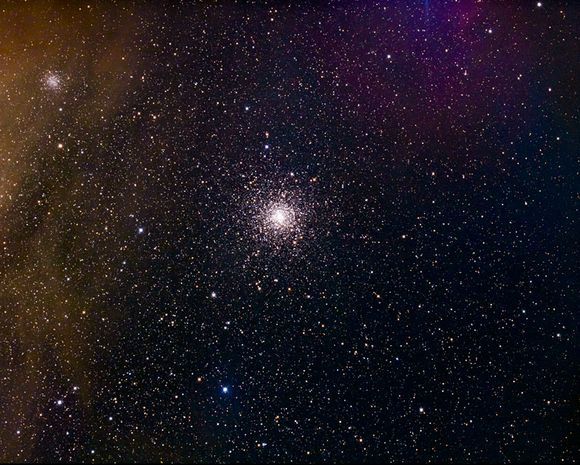
M4 - globular cluster -Scorpius
- M80 (NGC 6093) is a globular cluster discovered by Charles Messier in 1781. It has an apparent magnitude of 7.87 and is approximately 32,600 light years distant from the Sun. M80 is about 95 light years in diameter and contains hundreds of thousands of stars. It is one of the most densely populated clusters in our galaxy. It lies halfway between the stars Antares and Acrab.
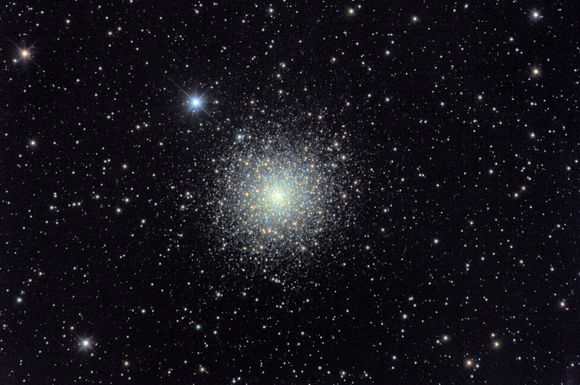
M80 - globular cluster -Scorpius
- M6 (NGC 6405) - known as the Butterfly Cluster because its stars form a shape similar to that of a butterfly. The cluster was discovered by the Italian astronomer Giovanni Batista Hodierna in 1654 and Charles Messier included it in his catalogue in 1764. The bright stars in M4 are mostly hot, blue, class B stars, but the brightest one is a class K orange giant, BM Scorpii. The Butterfly Cluster has an apparent magnitude of 4.2 and is approximately 1,600 light years distant from the Sun.
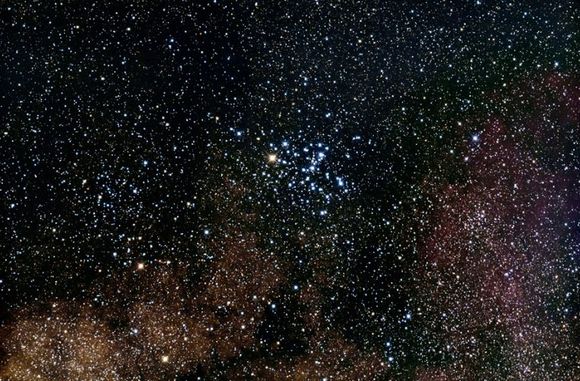
M6 - the Butterfly cluster -Scorpius
- M7 (NGC 6475) another open star cluster in Scorpius, located near the scorpion’s stinger. It has an apparent magnitude of 3.3 and is easily visible to the unaided eye. It is also known as the Ptolemy Cluster because it was the Greek astronomer Ptolemy who first recorded it in 130 AD. Ptolemy believed the cluster to be a nebula. The Ptolemy Cluster contains about 80 stars, the brightest of which has a visual magnitude of 5.6. M7 is approximately 980 light years distant from the solar system. It is roughly 25 light years in diameter. The age of the cluster is estimated to be around 200 million years. Both M6 and M7 are difficult Messier objects to view and appreciate from the UK being so low to the horizon.
There are numerous other deep sky objects, many of which are not visible from the UK. Of those that are visible NGC 6124 is a bright, large open cluster in Scorpius. It has an apparent magnitude of 5.8 and is approximately 18,600 light years distant from the solar system. The cluster contains about 125 visible stars. It was discovered by the French astronomer Nicolas Louis de Lacaille in 1751.
Chart/image credits - Stellarium and Starry Night Pro Plus 6 plus/ ESA
- Log in to post comments

